|
Rhodes Island
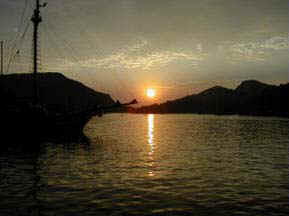 Rhodes
is the largest of the Dodecanese islands and one of the largest in the
Aegean sea. It is situated approximately 17,7 km from the coasts of
Turkey. The population is about 130.000 persons , of which approximately
60-70.000 reside in the city of Rhodes. Rhodes called from its local
people the Rose of the Aegean and deserves its name because is one of
the most beautiful Greek islands. Rhodes has the oldest tourist history
from all the islands of Greece . Rhodes town is divided to the new town
and the old town from the big medieval wall. Rhodes
is the largest of the Dodecanese islands and one of the largest in the
Aegean sea. It is situated approximately 17,7 km from the coasts of
Turkey. The population is about 130.000 persons , of which approximately
60-70.000 reside in the city of Rhodes. Rhodes called from its local
people the Rose of the Aegean and deserves its name because is one of
the most beautiful Greek islands. Rhodes has the oldest tourist history
from all the islands of Greece . Rhodes town is divided to the new town
and the old town from the big medieval wall.
The beauty of Rhodes town is the old town with the medieval castles
,houses and streets. At the port the visitor will find Mandraki with its
circular Market and the Cafes at the seafront ,further on are the Art
Deco buildings of the Metropolis from the times of the Italian
occupation. At the entrance of the port are the famous two columns with
the two Deers at the place where supposed to be the colossus of Rhodes
.The ancient city of Lindos is another of the main Attractions of the
island.
HISTORY OF RHODES
Rhodes was inhabited at the
Neolithic era. In 322BC, Rhodes was joined with the empire of Alexander
the Great. After his death , Rhodes maintained in close trade with the
kingdom of Ptolemy's in Egypt. In 164BC, Rhodes signed a treaty with
Rome. At the first century of our era,St Paul visited the island.
Between 1307 and 1522, the island was the seat of the order of Knights
of St John of Jerusalem. The Knights occupied Rhodes in 1307 and
completed the conquest in 1310 . They strengthened the city, leaving the
Great current walls. In the low part of Rhodes, they built the palace of
the Great Master . The island was a first seat in 1480, before falling
to the hands from the Turks from Soleiman the Magnificent in 1522, after
a five month siege. In 1912, Italy seized the island which belonged to
the Turks then. The island reunited with Greece in 1948.The Colossus of
Rhodes
After defeating Demetrius Poliorcetes in 305 BC, the citizens of Rhodes
used their booty to erect a thank offering to their divine patron
Helios. Chares of Lindos, a pupil of Lysippus, built (292-280 BC) a
bronze statue of the nude young god wearing a sun-ray crown and looking
out to sea. Many stories exaggerate the size of the statue; it must,
however, have been approximately 36 m (120 ft) high on a base of white
marble 6-7.5 m (20-25 ft) high and thus larger than any other statue. It
stood beside, not over, the harbor. Although reinforced with stone and
iron, the Colossus broke at the knees and fell in an earthquake 60 years
later. It remained a wonder until the Arab invasion (AD 653), when it
was broken up and sold for scrap metal. Nothing of it remains except
very dubious copie.
SITES TO VISIT IN RHODES
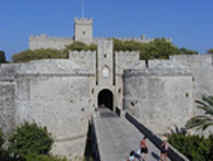 The
Medieval City The
Medieval City
During the 14th and 15th centuries the Knights of the
Order of St. John extended the Byzantine city and reinforced its
fortifications creating the medieval town of Rhodes. Of note is the
architecture in the gothic style developed in Provence at the Papal
Court of Avignon (1309-1424) with which the Knights maintained close
ties.
Eleven gates provided access to the city which is divided into two
parts: The Collachium, where the Knights resided - the most impressive
buildings from that time are located here: the Grand Master's Palace,
the Infirmary and the Langues -
and the Burgo, the main town.
The Old Town, as the locals call it, is today one of the best preserved
fortified medieval towns and has been listed by UNESCO and a world
cultural heritage monument. Walking down its paved streets, admiring the
imposing Knightly buildings, the walls and their dry moat and the
bastions, the Byzantine churches and the mosques, the squares, gardens
and courtyards of houses, the visitor feels that time has stopped while
at the same time discovering that this unique town is still living, full
of surprises and just asking you to explore it.
The Knights' Street
(Odhos Ippoton) is 200 m long and 6 m wide. It was the main official
street connecting the religious and political centre of the fortress, in
other words the Catholic Cathedral (Panaghia Kastrou) and the Palace of
the Grand Master. Along its length are the most important public and
private buildings erected by the Knights. Here, with few exceptions, is
the accommodation for the Knights, the "Langues", the national divisions
of the Order of the Knights of St. John. The street is inclined and
unusually for a medieval city completely straight. That is one
indication that it was first marked out in antiquity. This was retained
by the Knights precisely because the strict linear layout suited them
and the new political importance they attached to it.
Visit the
Clock Tower
built in 1851 which was once used as lookout post. It has a small
collection of archaeological finds discovered there. The view of the Old
Town from the tower is breathtaking.
Panaghia Bourgou is a late gothic church dating from the 14th century.
It was bombed during World War II and today the three apses of the
sanctuary are what remain.
Sokratous St. ends in Ippokratous Square. It is the main commercial
street in the Old Town. Around the square with its large fountain are
many bars, restaurants and nightclubs.
Of the many impressive mosques in the Old Town the Suleyman Mosque is
truly noteworthy. The present-day building was constructed in the 19th
century on the site of an older one which tradition says was erected by
the town's conqueror Suleyman the Magnificent. Note the intricate marble
entrance which comes from a grave monument from the time of the knights.
In Dorieon Sq. lies Retzet Pasha Mosque.
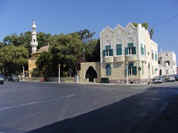 New
Town New
Town
The
Temple of Aphrodite
from the 3rd century BC. Its ruins were unearthed in the heart of the
new town between Mandraki and Akandia Port in Symi Square.
Murat Reis Mosque with its elegant minaret lies near the Prefectural
Building. It is built on the site of Aghios Antonios Church next to the
Knight's Cemetery. The Turkish cemetery contains the tombs of exiled
Turks, an admiral of Suleyman II's fleet in a round mausoleum and a poet
banished by the Sultan for his sarcastic poetry. In the square around
the mosque the ruins of the ancient walls have been found together with
inscribed stone balls marked with their weight. They begin at 5 mnes and
reach 10 talents (2 to 261 kilos approximately). From the type of
letters the balls have been dated to the famed siege by Dimitris
Poliorcetes. Aghios Nikolaos lighthouse is a fortress at the end of the
jetty with the same name where the deer statutes stand at the entrance
to the port welcoming visitors to the island.
At the other end are three windmills. The first houses the offices of
the Army Hydrographical Service where maritime maps can be purchased.
The second from the 15th century operates as a museum. One can see the
grinding mechanism while the third houses a travel agency.
Aghios Stefanos Hill also known as Monte Smith after an English admiral
of Napoleon who called at the island in 1802. In the well laid out and
verdant archaeological park are the surviving remains of a 3rd century
BC Stadium where the Alies Games were held, the largest celebration for
the Ancient Rhodians in honour of the god Helios.
Next to the stadium a small, marble open-air theatre has been restored
and is used for musical performances just like in antiquity.
At the peak of the hill is the temple of Apollo Pythia, protector of the
city. From here the view over the town and the sea is panoramic and the
sunset enchanting.
The tombs of St. John are in the central part of the extensive Rhodian
necropolis. Important monuments are the large corner tomb complex with
domed graves, the group of domed graves crowned by a monument with
triglyphs and metopes and the tomb carved into the rock with a
monumental gateway. Of most interest is the underground quarry into
whose tunnels grave chambers were dug.
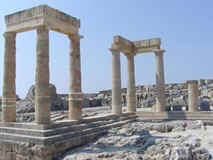 LINDOS LINDOS
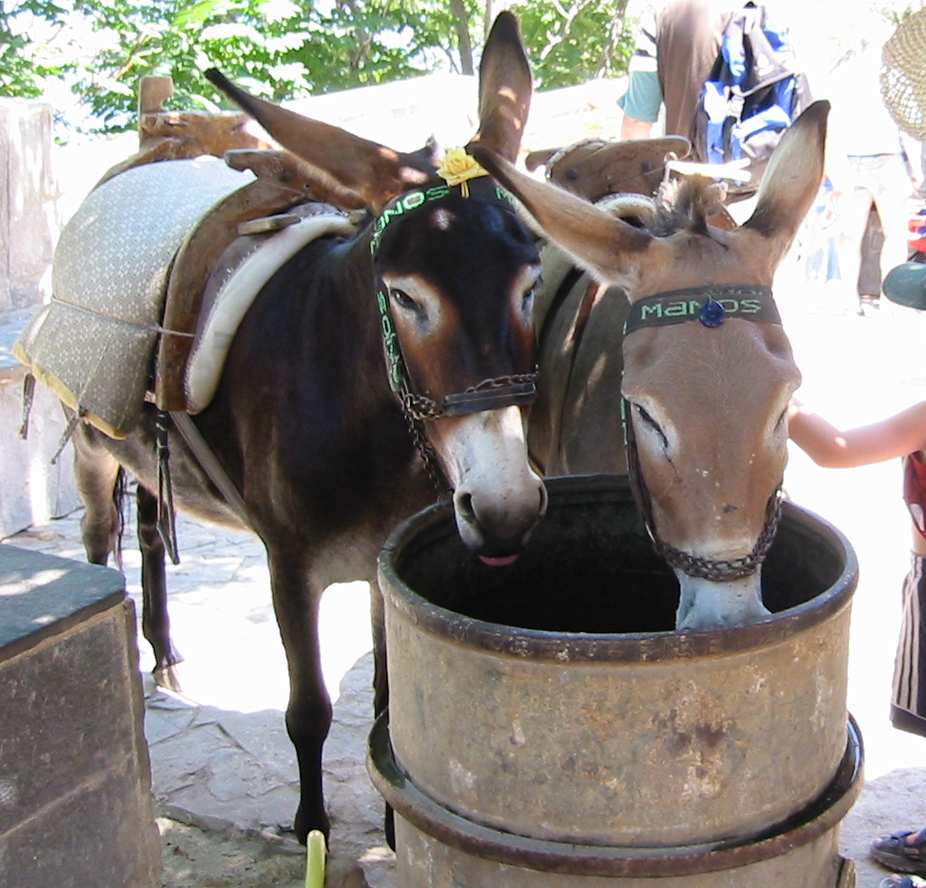 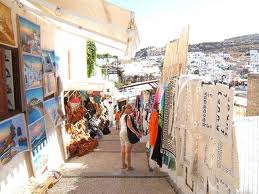 Lindos
(46 km from Rhodes town) Lindos
(46 km from Rhodes town)
The listed village of Lindos has preserved its architectural uniqueness
as well as its traditional decoration. White, boxy houses with flat
roofs, imposing entrances leading into courtyards filled with flowers
accessed along pebbled streets are situated around a sheltered port and
lead up to the acropolis. The climb is via picturesque narrow streets on
foot or on Lindos 'taxi', donkeys.
The acropolis of Lindos is built on a precipitous rock soaring 116 m and
dominating the village. It is a real balcony with a view over the sea.
The monuments there are evidence of the power and wealth of Lindos over
the ages.
|
|
Tilos Island
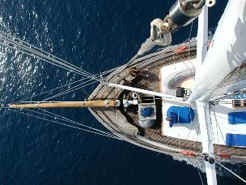  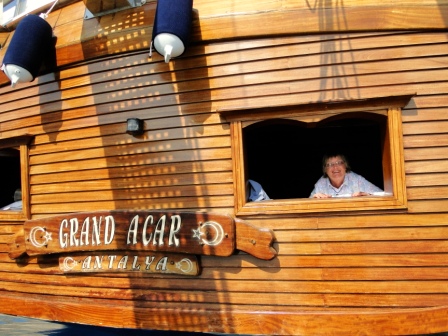 Tilos is
an Aegean island with nineteen beaches, twelve mountains,
seven medieval castles, a Byzantine monastery and two
hundred churches, a cave full of natural discoveries, a
village that is a declared cultural monument, a hundred bird
species, hundreds of wild flowers and herbs, and five
hundred residents. Livadia is the island’s main port Livadia
was established around 1930 as a village although it had
existed as a harbour before that. Most of the buildings are
modern mixed with a few traditional ones. Livadia has a
lovely horseshoe bay which is excellent for swimming and
snorkelling, there is also shade along the beach beneath the
Tamarisk trees. These trees were originally planted as a
windbreak to protect the crops grown in the very fertile
soil along the front. The North winds are so dry they can
‘burn’ crops. Above the village is the remains of a 15th
century castle – Agriosikia and in the valleys below the old
monastery Politissa Tilos is
an Aegean island with nineteen beaches, twelve mountains,
seven medieval castles, a Byzantine monastery and two
hundred churches, a cave full of natural discoveries, a
village that is a declared cultural monument, a hundred bird
species, hundreds of wild flowers and herbs, and five
hundred residents. Livadia is the island’s main port Livadia
was established around 1930 as a village although it had
existed as a harbour before that. Most of the buildings are
modern mixed with a few traditional ones. Livadia has a
lovely horseshoe bay which is excellent for swimming and
snorkelling, there is also shade along the beach beneath the
Tamarisk trees. These trees were originally planted as a
windbreak to protect the crops grown in the very fertile
soil along the front. The North winds are so dry they can
‘burn’ crops. Above the village is the remains of a 15th
century castle – Agriosikia and in the valleys below the old
monastery Politissa
Megalo Horio
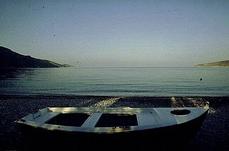 The
capital of the island with just 180 full-time residents.
Megalo Horio (Big Village) is much older and more
traditional Greek village with winding alleyways and
traditional buildings. There is one road that runs past the
village but the majority is inaccessible by car. There are
some beautiful churches here – the Church of Archangel
Michael (Taxiarchis) opposite the Island Council Offices and
Panagia on top of the village. On the summit above the
village is the most complete of the seven Crusader castles
on the island. It’s a steep climb up with no shade but
stunning views from the top. Also here is the Elephant
Museum – where finds from the Harkadio Cave are displayed –
if the museum is closed, ask at the council offices (go up
the stairs to the left of the museum). Vicky the guide is
usually around to fill you in on all the necessary details!
Also in Megalo Horio is another pharmacy/doctor’s surgery. The
capital of the island with just 180 full-time residents.
Megalo Horio (Big Village) is much older and more
traditional Greek village with winding alleyways and
traditional buildings. There is one road that runs past the
village but the majority is inaccessible by car. There are
some beautiful churches here – the Church of Archangel
Michael (Taxiarchis) opposite the Island Council Offices and
Panagia on top of the village. On the summit above the
village is the most complete of the seven Crusader castles
on the island. It’s a steep climb up with no shade but
stunning views from the top. Also here is the Elephant
Museum – where finds from the Harkadio Cave are displayed –
if the museum is closed, ask at the council offices (go up
the stairs to the left of the museum). Vicky the guide is
usually around to fill you in on all the necessary details!
Also in Megalo Horio is another pharmacy/doctor’s surgery.
Mikro Horio
Mikro Horio was the original capital of the
island and was once home to 1700 people. The village is now
deserted – the residents either emigrated or moved down to
the Livadia to be closer to the developing port. Nowadays
the village is like a time-capsule a witness to a life that
no longer exists. It is very atmospheric
to wander around. The bus does not go to Mikro Horio but it
is not too long a walk.
Harkadio
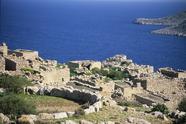 On
the left hand side of the road to Megalo Horio is the
Harkadio Cave where the remains of dwarf elephants were
discovered in 1971. The cave is not open to the public as
excavations are still continuing. However, the view from
outside the cave is wonderful and underneath is a small
amphitheatre which is host to concerts during the summer
months. Stand in the centre to experience the perfect
acoustic! Nearby the entrance, you will see the construction
of the new museum which will eventually contain the finds
made in the cave. Some are presently on display in the small
museum in Megalo Horio but the majority are in Vienna. The
bones of thousands of elephants have been found in the cave
and the discovery was on of the first to establish the
existence of elephants in Europe - it is thought that they
swam here from Africa and the dwarfism developed due to a
gradual decline in the population due to hunting by man. On
the left hand side of the road to Megalo Horio is the
Harkadio Cave where the remains of dwarf elephants were
discovered in 1971. The cave is not open to the public as
excavations are still continuing. However, the view from
outside the cave is wonderful and underneath is a small
amphitheatre which is host to concerts during the summer
months. Stand in the centre to experience the perfect
acoustic! Nearby the entrance, you will see the construction
of the new museum which will eventually contain the finds
made in the cave. Some are presently on display in the small
museum in Megalo Horio but the majority are in Vienna. The
bones of thousands of elephants have been found in the cave
and the discovery was on of the first to establish the
existence of elephants in Europe - it is thought that they
swam here from Africa and the dwarfism developed due to a
gradual decline in the population due to hunting by man.
|
|
Simi Island

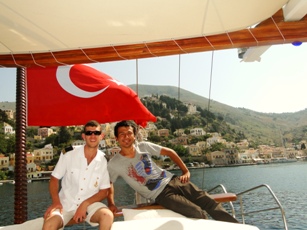 SYMI or
Simi is one of the smaller holiday islands in the Dodecanese
group just 9km off the Turkish coast and north from Rhodes.
Boat building and sponge diving once made the island rich;
now tourism has taken. Symi is noted for peace and
tranquillity rather than beaches, which are in short supply.
Symi is also much noted for summer temperatures, which can
soar to 38°C. SYMI or
Simi is one of the smaller holiday islands in the Dodecanese
group just 9km off the Turkish coast and north from Rhodes.
Boat building and sponge diving once made the island rich;
now tourism has taken. Symi is noted for peace and
tranquillity rather than beaches, which are in short supply.
Symi is also much noted for summer temperatures, which can
soar to 38°C.
The neo-classical mansions that hang off the hills around
the main port are a reminder of the rich pickings once
enjoyed by the inhabitants.

HISTORY OF SIMI
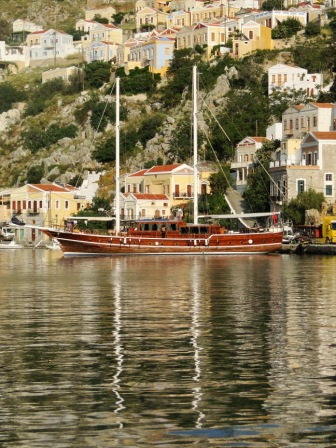 |
In
spite of being a small island, Simi holds a rich history
that dates back
to ancient times.
In fact, Homer mentioned this island in the Illiad because
of its role on the Trojan War, as it was headed by the
Simian King Nireas. In addition, Herodotus referred to Simi
as a member of the Dorian Hexapolis –meaning ‘6 cities’. In fact, since 480 B.C. Simi belonged to the
Athenian League However, the old island of Simi was not
always known by its current name, as it was formally called:
Kirki, Metapontis and Aigli. The name we use today is
related to mythology, and is taken from the nymph Simi, who
married Poseidon, the god of the sea and gave birth to the
later leader of the island’s inhabitants, Hithonios.
|
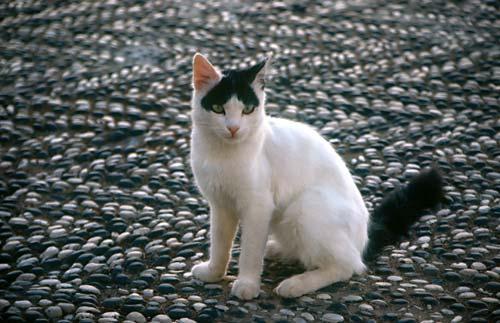 |
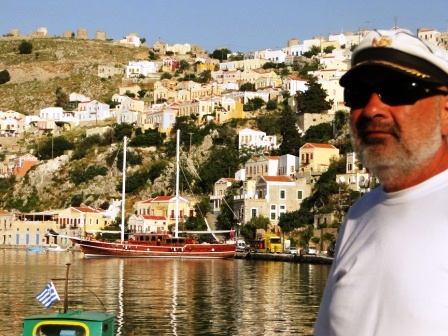
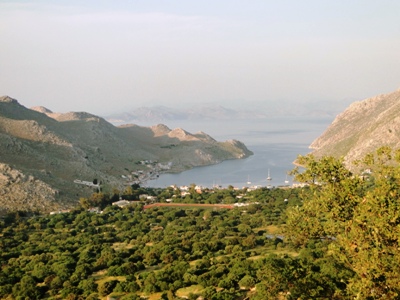 |
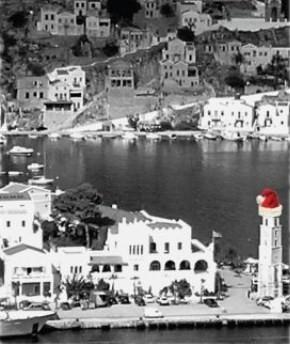 |
|
|
Dalyan, Turkey
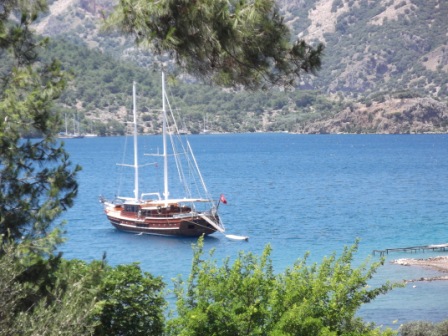 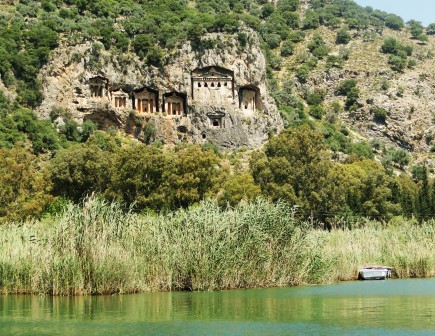 The
Mediterranean can be called the sea of legends.
This is the result of the infinite beauty of nature. In the course of
the centuries, man has exploited a large part of this beauty for his own
ends. That is why we can observe the constant strength of civilization
in and around these waters that we will be sailing.
These waters were also the source of ecstasy and rapture.
In fact they were well known to the powerful gods and goddesses of
nature who danced and sang in the revels of Dionysus and to all the
peoples of the Mediterranean. They left evidence of all this to
posterity by exploiting their skills to the full in every stone and
every piece of marble they carved, in every mural they painted, in every
inscription they wrote. The
Mediterranean can be called the sea of legends.
This is the result of the infinite beauty of nature. In the course of
the centuries, man has exploited a large part of this beauty for his own
ends. That is why we can observe the constant strength of civilization
in and around these waters that we will be sailing.
These waters were also the source of ecstasy and rapture.
In fact they were well known to the powerful gods and goddesses of
nature who danced and sang in the revels of Dionysus and to all the
peoples of the Mediterranean. They left evidence of all this to
posterity by exploiting their skills to the full in every stone and
every piece of marble they carved, in every mural they painted, in every
inscription they wrote.
After a three hour of sailing, we will arrive at the entrance of Dalyan
River. We will transfer to our river boat and cruise through the amazing
maze of the river. The tombs carved in the cliffs of the steep hills
will stand like an evidence to the civilization once enjoyed this
spectacular beauty.
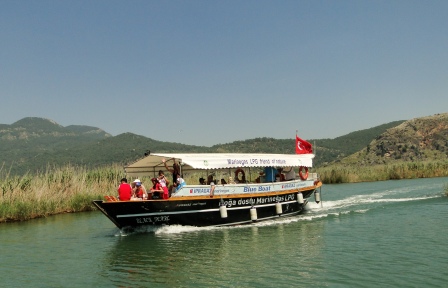
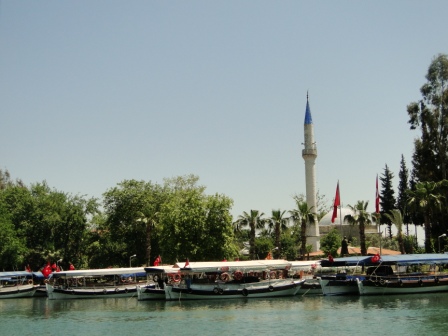
The restaurants
on the river specialize on crab and fish. Lunch today will not be
included in the tour price so that you can all experience
delicious food in this little river side village. When we return to "
Grand Acar", for those who are interested, we can have a cooking
class
by our chef Mehmet. Those who prefer a quite afternoon can hike in the
forest, swim or do nothing.
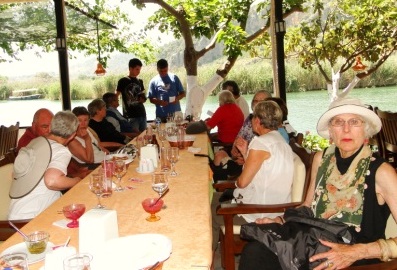
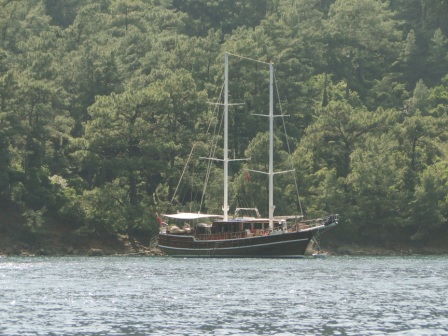
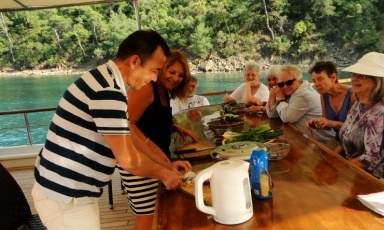
|


